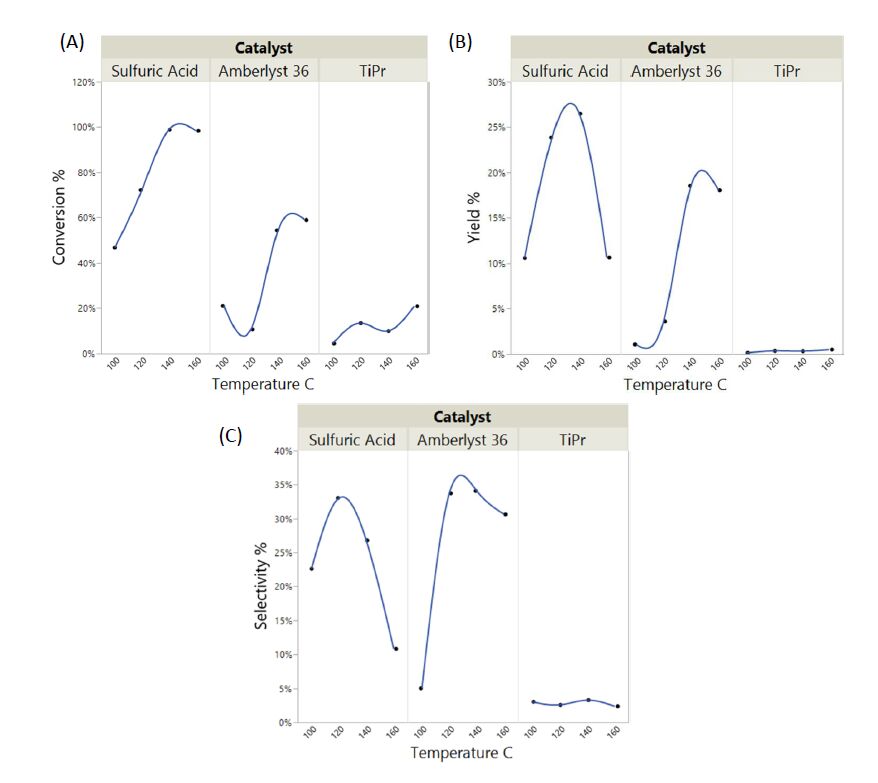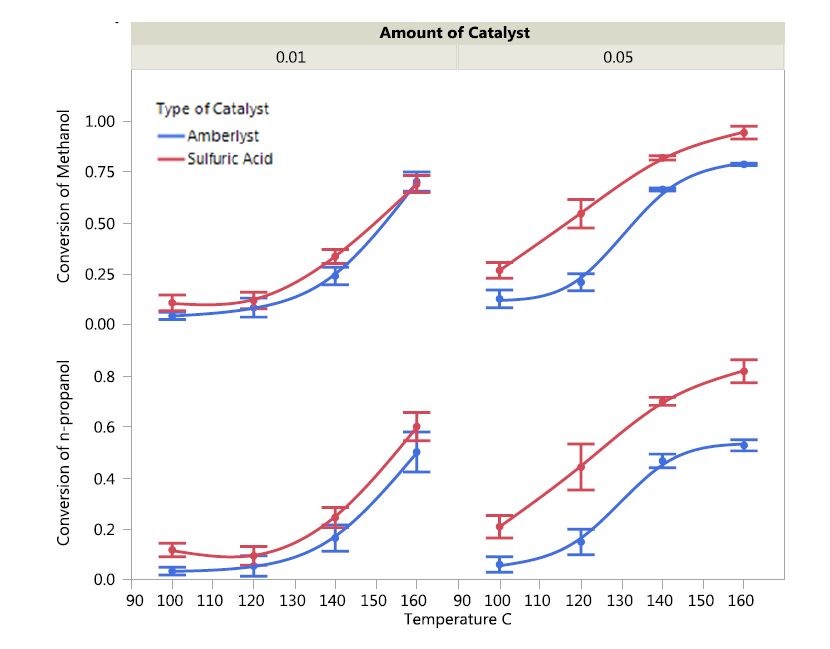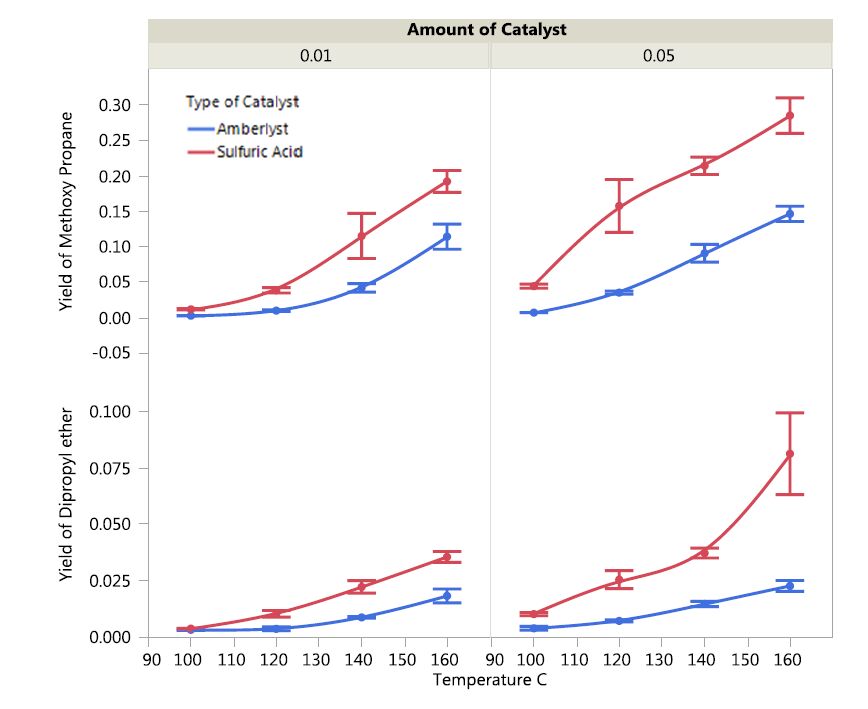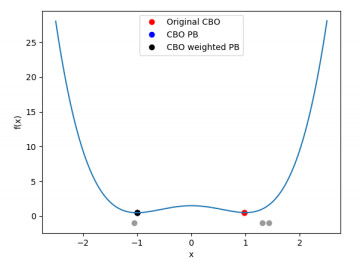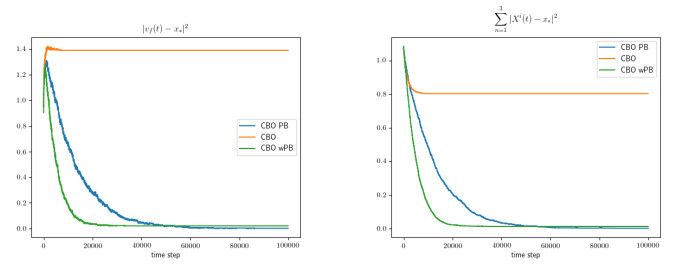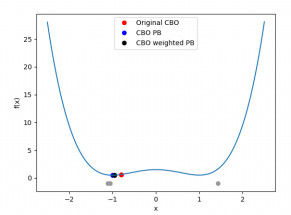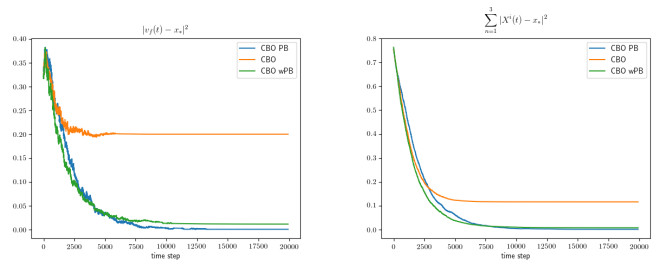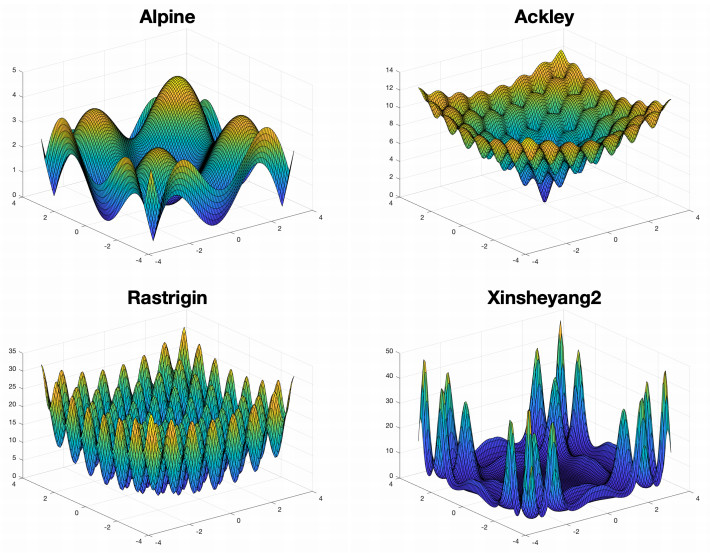1. Introduction
Due to the advances of biodiesel industry, a glut of glycerol has been resulted and there is a need for finding alternative uses for methanol contaminated glycerol. Due to the chemical composition of glycerol and methanol, dehydration and rearrangement could result in deoxygenated products that could be used as fuel additives. However, how methanol-containing glycerol could be converted into dehydrated products have not been widely investigated. This work attempts elucidating reaction conditions and performance parameters of an analogous system using methanol and n-propanol as the reactants while using catalysts that have been proven to be effective for transesterification.
Ethers consist of an oxygen atom bonded to two alkyl or aryl groups, or one alkyl and one aryl group [1]. Ethers have properties that might be beneficial as fuel additives to biodiesel and other biofuels. Boiling point is relatively low for ethers compared to their alcohol analogs which makes ethers more safe. Also, ethers have good solubility in hydrophilic and hydrophobic solvents making them compatible with esters such as biodiesel [2].
Ethers can be synthesized through several methods. The most common ones are bimolecular dehydration and Williamson method [1,3]. In dehydration reaction, alcohol is treated with a strong acid under dehydrating conditions. The general equation for dehydration reaction would be as follows [4]:
|
ROH + R ′ OH↔ROR ′ + ROR+ R ′ OR ′ +H2O
|
(1)
|
More specifically, above reaction may proceed according to following elementary steps:
ROH ↔ ROR
R'OH ↔ R'OR'
ROH + R'OH ↔ ROR'
In this work, we will use bimolecular dehydration to produce di-propyl ether (DPE) and methyl propyl ether (MPE) from methanol and n-propanol. It is anticipated that when a mixture of two alcohols was reacted through etherification, the result would be a mixture of three types of ethers as given in Scheme (1). In this case, three products, i.e., DPE, MPE, and dimethyl ether are anticipated.
Ethers that could result from methanol-contaminated glycerol dehydration, i.e., DPE and MPE have been of interest in chemical and pharmaceutical industry. DPE, a common oxygenated hydrocarbon, is used widely in industry as a solvent [5,6]. MPE is an isomer of diethyl ether, and has found many applications such as analgesic reagent [7], anesthetic [8] in the medical industry and a solvent (reference) and fuel additive [9] in the chemical industry.
DPE can be prepared from reacting 1-propanol by dehydration [10]. It has been predicted that DPE can be obtained through dehydration reaction from an already separated mixture of DPE and n-propanol using sulfuric acid as a catalyst. The mixture would be separated using extractive distillation and pressure-swing distillation [10]. Another general example is producing diethyl ether from ethanol dehydration. This work was done in the range of temperature of 140-250 °C with three different catalysts [11]. 1-Butanol has also been used to produce di-butyl ether; in that work, acidic ion-exchange resin Amberlyst 36 was used as the catalyst [12].
MPE has been produced as fraction of biocrude produced using Hydrothermal Upgrading (HTU) process by thermochemical conversion of biomass. This process requires high temperature and pressure, around 350 °C and 180 bar respectively [13]. However, MPE comprised of only 2.5% of the bio-crude produced. Other work done on methanol-isobutanol, ethanol-isobutanol and, ethanol etherification [11] also followed dehydration principle [14]. Above examples show that dehydration is a feasible method to produce ethers using alcohols.
Work to date on dehydration reveals that the yields are still low. Also, the high temperatures and pressures required make the process energy intensive and less economical. Additionally, there is little work has been done on strategies to increase the yield, conversion, and selectivity of ethers produced from common alcohols. This present work is geared toward identifying key parameters that impact alcohol conversion and ether yields and selectivity using methanol and 1-propanol with the intention of identify the best combination of parameter that would cost effectively produce dehydrated ethers. The novelty of this work is the study of the impact of three different catalysts that have distinct properties, i.e., sulfuric acid (a homogeneous duel proton donor), Amberlyst 36 (a heterogeneous strongly acidic cation exchanger) and titanium isopropoxide (a condensable base in the isopropoxide form that becomes acidic once condensed to TiO2).
2. Material and Methods
Initial studies were conducted to establish catalysts and conditions that promote n-propanol etherification to form di-propyl ether. The rationale was that these variables would be a good starting point for MPE synthesis using methanol and n-propanol.
Studies with n-propanol were conducted in the presence of 1% (w/w) sulfuric acid, Amberlyst-36, and titanium isopropoxide. The reaction temperatures ranged from 100-160 °C at 20 °C intervals with a reaction time of 4 hrs.
Etherification studies on n-propanol methanol mix was conducted with select catalysts identified based on proposal etherification studies under the same conditions. The only exception was that in this case, 1% and 5% (w/w) of catalyst concentrations were tested. In this case, three products, i.e., DPE, MPE, and dimethyl ether (DME) are anticipated. However, we will report DPE and MPE data as a result of DME being a gaseous product and is of less use as a liquid fuel additive.
Response Measurements:
Primary variables that were calculated include substrate conversion, product yield and selectivity. For the case with n-propanol, aforementioned variables were calculated as follows:
Yield of DPE = n(DPE)no(n−propanol)
Selectivity toward DPE = n(DPE)n0(n−propanol)+n(n−propanol)
Propanol conversion = n0(n−propanol)−n(n−propanol)n0(n−propanol)
Where: n = final number of moles; no = initial number of moles.
When a methanol and propanol mixture was used, the variables were calculated as follows:
Ether yields:
Yield of DPE = n(DPE)n0(n−propanol)
Yield of MPE = n(MPE)n0(n−propanol) + n0(methanol)
Ether selectivity:
Selectivity toward DPE = n(DPE)n(DPE)+n(MPE)
Selectivity towards MPE = n(MPE)n(DPE)+n(MPE)
Substrate conversion:
Propanol conversion = n0(n−propanol)−n(n−propanol)n0(n−propanol)
Methanol Conversion = n0(methanol)−n(methanol)n0(methanol)
Where: n = number of moles; n0 = initial number of moles.
2.1. Materials
2.1.1. N-propanol Etherification
Three catalysts were used: Sulfuric acid was obtained from J.T. Baker with an assay of 95.9%; Amberlyst 36 was provided from Sigma Aldrich with a water content of (51-57) % and a total pore volume of 0.2 mL/g, particle size 0.6-0.85 mm, surface area 33 m2/g, >1.95 eq/L exchange capacity; Titanium isopropoxide (colorless to yellow liquid with a density of 0.96 g/mL at 20 °C, boiling point of 232 °C, and molecular weight of 284.22 g/mol) was provided by Alfa Aesar company with >97% purity. All the catalysts were used at 5% w/w concentration.
Other reactants used were n-propanol and di-propyl ether and were obtained from Sigma Aldrich with a purity >99%.
2.1.2. Methanol and N-propanol Etherification
Methanol (99.8% assay with a maximum of 0.1% water content) was obtained from VWR. Other reactants, n-propanol (99.7% assay), di-propyl ether (>99% assay) and MPE (97% assay), were obtained from Sigma Aldrich. Methyl-propyl-ether (Methoxypropane) and Di-propyl-ether were used as standards.
2.1.3. Equipment
The reactions were carried out under stirring in a 25-mL high pressure vessel (Buchiglas USA) rated for 100 bar at 200 °C with temperature/pressure readout (it should be noted that the pressure in the vessel varied based on reaction temperature, and type and concentration of catalyst. The pressure in general ranged between (5-30) bar for Amberlyst 36, and between (10-40) bar for sulfuric catalyzed reaction). Weight measurements were carried out in a scale (PA 120) (with 0.001 mg sensitivity). Quantitative product analyses were carried out in a Gas Chromatograph (Agilent Technologies Model 6850) and Liquid Chromatograph (Agilent Technologies Model 1120 Compact LC).
2.2. Methods
2.2.1. Reaction Procedure (n-propanol etherification)
The reaction between two n-propanol molecules in the presence of acid catalysts is expected to proceed according to Scheme (2) as follows:
The reaction is exothermic; however, energy input is necessary to overcome kinetic limitations. Therefore, the reaction progresses only with adequate energy input.
In terms of the methods, initially, the empty weight of a 32-mL vial was recorded. Then, reactants were added into the vial in a stepwise manner starting with 4 mL of n-propanol and 5% w/w of catalyst (note: equal catalyst weights were used since catalytic activity comparisons in biodiesel production generally uses mass basis rather than proton concentrations). The weight of the vial after addition of the chemical(s) was recorded. When the catalysts were solid, the weight of the catalysts was recorded separately. The chemicals and the magnetic stir-bar were added to the reactor securely sealed and placed in a stir hotplate (with stirring speed 700-800 rpm) for the reactions to progress. Once the reaction was over, the products were swiftly transferred to collection vials and sent for further analyses (GC, LC or weight/volume measurement) as needed.
2.2.2. Reaction Procedure (Methanol and propanol)
The reaction between methanol and propanol progresses according to Scheme (3) as follows:
|
2CH3OH(l)↔ C2H6O(g) + H2O2C3H8O(l)↔ C6H14O(l) + H2OCH3OH(l) + C3H8O(l)↔ C4H10O(l) + H2O}
|
(3)
|
The procedure for methanol and n-propanol etherification was similar to above except that the amounts of the reactants were different, i.e., 2 mL of methanol and 2 mL of n-propanol. The catalysts used in this case were sulfuric acid and Amberlyst-36 at 1% and 5% w/w concentrations.
2.2.3. Calibration Standard Preparation
The calibration standard consisted of methanol, n-propanol, methoxypropane, and di-propyl ether. Standard curves were developed by mixing above chemicals in predetermined ratios. When necessary, an internal standard (ISTD) was also used. An ISTD was used to account for any errors associated with sample handling. This was done by incorporating a correction factor as a result of internal standard analyses.
2.2.4. Gas Chromatography (GC) Analysis
The top phase of each sample was analyzed via the GC. Each sample consisted of 1 mL total volume. The GC method consisted of following parameters:
· Column Information: Model (J&W 122-703E), Capillary Column with dimensions (30 m × 250 μm × 0.25 μm)
· Inlet type (EPC split-splitless inlet), and temperature is 220 °C
· Outlet Temperature: 240 °C
· Oven Temperature: 250 °C
· Gas Carrier and flow rate: Helium, 1.0 mL/min
· Detector: Flame Ionized Detector
2.2.5. High Performance Liquid Chromatography (HPLC) Analysis
The bottom aqueous phase was analyzed using HPLC. After separation from the top phase, the bottom phase was neutralized and filtered (to remove any solid material) before injecting to the HPLC. Neutralization was performed using NaOH for acid catalyzed reactions. During neutralization, the neutralizing solution (NaOH) was added dropwise while stirring and monitoring pH. The sample was considered neutral when the pH reached 7.0 ± 0.1. Sample filtration was done sequentially using 0.8 μm, 0.45 μm, and 0.25 μm syringe filters respectively. Then, samples were diluted as appropriate to be compatible with HPLC column and injected manually to HPLC. The HPLC method consisted of following parameters:
· Column Information: Supelcogel 610H (30 cm × 7.8 mm).
· Flow rate: 0.5 mL/min.
· Mobile phase: 0.1% phosphoric acid.
2.2.6. Statistical design
The n-propanol etherification was done as a Completely Randomized Design (CRD) that consisted of 12 units whereas methanol and propanol etherification was done as a full factorial design. In this design, all the variables and levels were randomized with three replicates using JMP software (SAS Institute). Results were obtained, organized, and analyzed using JMP software as well.
3. Results and Discussion
3.1. Propanol etherification
Substrate conversion and DPE yields & selectivity information is depicted in Figure 1. According to Figure 1A, the conversion clearly increased with increasing temperature for all the catalysts tested. Sulfuric acid clearly resulted in higher substrate conversions as compared to the other two catalysts for each temperature. Interestingly, at 140 and 160 °C, sulfuric acid resulted in complete conversion of di-propyl ether. Titanium isopropoxide performed the least with the highest conversion being only ~20% at 160 °C.
DPE yields followed a similar trend to propanol conversion (Figure 1B). Again, sulfuric acid resulted in the highest DPE yields at 140 °C. It was interesting to note that the yields dropped at 160 °C, likely due to product disintegration. DPE yields increased with increasing temperature when Amberlyst-36 was used as the catalyst; however, the yields were lower as compared to when sulfuric acid was used. No significant ester yields were observed with titanium isopropoxide.
It should be noted that based on the selectivity equation used, the maximum selectivity obtainable in this situation is 50%. Interestingly, Amberlyst-36 resulted in the best selectivity toward DPE from the three catalysts tested. Sulfuric acid performed similar to Amberlyst-36 but with slightly lower overall selectivity values. It was evident in both cases, i.e., sulfuric acid and Amberlyst-36, that there was an optimum temperature that renders highest product selectivity which was ~120 °C for both catalysts. Again, titanium isopropoxide did not show any appreciable selectivity toward etherification.
The impact of temperature and type of catalyst on propanol conversion, DPE yield and the selectivity toward DPE are given in Table 1.
ANOVA indicates that temperature alone doesn't impact the conversion, yield or selectivity; however, the type of catalyst has a significant impact on all of the above responses. How the temperature and type of catalyst impacted propanol conversion, DPE yield and the selectivity toward DPE are depicted in Figure 1A, B and C respectively.
Table 1. Analysis of variance (ANOVA) of effect of temperature and type of catalyst on propanol conversion, DPE yield and the selectivity toward DPE.
| Factor |
Conversion |
Yield of DPE |
Selectivity towards DPE
|
| Temperature °C |
P = 0.0502 |
P = 0.3526 |
P = 0.3785
|
| Type of Catalyst |
P = 0.0012 |
P = 0.0312 |
P = 0.0249
|
| P < 0.05 indicates significance |
3.2. Propanol and methanol etherification
Substrate Conversion:The impact of catalyst type and concentration and temperature on n-propanol and methanol conversion is depicted in Figure 2.
It can be noted that sulfuric acid resulted in higher conversions of both n-propanol and methanol as compared to Amberlyst-36 even with the same concentration. This superiority in activity was evident at higher catalyst concentrations. This is likely as a result of the higher proton content in the case of sulfuric acid (twice as much protons) as compared to Amberlyst 36 per unit mass basis. The higher performance of sulfuric acid could also be attributed to the catalyst being homogeneous. Homogeneous catalysts generally perform better than heterogeneous catalysts due to much favorable mass transport characteristics in reactions [16,17,18]. Clearly, higher temperatures favored conversion of both substrates regardless of the type of catalyst; however, in a non-linear fashion. The better performance at higher temperature could be attributed to better reaction kinetics [19]. It was evident that methanol conversion was higher as compared to n-propanol and this could be attributed to more favorable steric of methanol (being the smaller of the two). Also, it should be noted that since methanol is initially in excess in the reaction medium, the fact that methanol conversion is higher than that of n-propanol implies that most of methanol may have converted in to byproducts such as dimethyl ether.
3.3. Product Yield
The yields of DPE and MPE as a function of catalyst type and amount for different temperatures are depicted in Figure 3.
Overall, sulfuric acid resulted in higher DPE yields as compared to Amberlyst 36 over the temperature range tested. DPE yields increased with increasing temperature for both catalysts. The DPE yield was 7.5% with 5% sulfuric acid catalyst at 160 °C. Although the DPE yields increased as temperature increased with both catalysts, Amberlyst lagged sulfuric acid in all instances. In terms of MPE yields, sulfuric acid resulted in better overall yields at all temperatures and catalyst concentrations as compared to Amberlyst 36. The yields tended to increase linearly with temperature for both catalysts.
3.4. Selectivity toward ether
The selectivity of the two catalysts, i.e., sulfuric acid and Amberlyst 36 toward production of and di-propyl ether are depicted in Figure 4.
It was interesting to note that the selectivity behavior of the catalysts for di-propyl ether was the antithesis to that of methoxypropane. In general, higher temperatures favored selectivity of both catalysts toward methoxypropane. At low temperatures, sulfuric acid showed markedly higher selectivity toward methoxypropane production as compared to dimethyl ether. However, as temperatures increased, the selectivity of Amberlyst 36 reached the same levels as sulfuric acid (at temperatures around 130 °C and even surpassed the values of sulfuric acid at higher temperatures). On the other hand, the selectivity of both catalysts toward di-propyl ether production was highest at low temperature and steadily declined as temperature increased. Amberlyst 36 was comparatively more selective toward di-propyl ether production as compared to production of methoxypropane. Also, both catalysts were comparatively more selective for methoxypropane production as opposed to production of di-propyl ether.
The impact of catalyst type, concentration and temperature on n-propanol and methanol conversion and yield and selectivity toward the products, di-propyl ether (DPE) and methyl-propyl ether (MPE) are presented in Table 2.
Table 2. Analysis of variance of impact of catalyst type, concentration, and temperature on conversion, yield and selectivity.
| Responses
|
| Factor |
Conversion of Methanol |
Conversion of n-propanol |
Yield of DPE |
Yield of MPE |
Selectivity towards DPE |
Selectivity toward MPE
|
| Temperature, °C |
P =<0.0001 |
P =<0.0001 |
P =<0.0001 |
P = 0.595 |
P =<0.0001 |
P =<0.0001
|
| Type of Catalyst |
P = 0.0003 |
P =<0.0001 |
P =<0.0001 |
P = 0.9 |
P = 0.0181 |
P = 0.0181
|
| Catalyst Concentration |
P =<0.0001 |
P =<0.0001 |
P = 0.0010 |
P = 0.0295 |
P = 0.0295 |
P = 0.0295
|
| Catalyst Concentration *Type of Catalyst |
P = 0.0181 |
P = 0.0089 |
P = 0.0176 |
P = 0.8815 |
P = 0.2027 |
P = 0.2027
|
| *P: Probability value for significance. P < 0.05 indicates significance. |
It can be seen that with the exception of catalyst concentration vs type interaction on product selectivity, all other factors significantly impacted the responses. This implies that applying different combinations of levels of the variables matter when it comes to substrate conversion, product yield and to a great extent, selectivity toward ethers.
In general, sulfuric acid resulted in comparatively higher conversions and ether yields. However, Amberlyst 36 gave comparable values of MPE yields and selectivity to sulfuric acid, especially when considering MPE. The high activity of sulfuric acid is likely as a result of the catalyst having a higher number of protons per mass basis. Sulfuric acid has twice number of protons as compared to Amberlyst 36. Also, it is possible that sulfuric acid being homogeneous would explain the higher activity (as opposed to Amberlyst being a heterogeneous catalyst) [20]. Homogeneous catalysts in general have a mass transport advantage in comparison to heterogeneous catalysts [18].
The higher selectivity of Amberlyst 36 for DPE production and surpassing the selectivity toward MPE at higher temperatures is interesting. It has been revealed during recent experiments that Amberlyst 36 has swelling capability [21]. This swelling capability has been associated with Amberlyst's ability to absorb water and polar components [22]. Karl-Fisher titration has revealed that the bottom product phase contains about 67% water. The ability of Amberlyst 36 to help remove the produced more efficiently than sulfuric acid may at least partially explain why Amberlyst 36 performed better under some conditions.
3.5. Mass Balance
A mass balance was conducted for the reaction that consisted with 1:1 methanol to n-propanol volume ratio (i.e., 0.128 mol (4.08 g) of methanol, 0.064 mol (3.83 g) of propanol) with 5% sulfuric acid for 4 h. The products on average were 0.0215 mol (1.59 g) of MPE (~20% w/w) and 0.0048 mol (0.49 g) of DPE (~6%). The rest 5.83 g (~74%) were distributed among bottom phase (water and unconverted alcohol), and gaseous products.
Based on the above experiments, it is clear that nearly all the variables tested, i.e., catalyst type & concentration and reaction temperature, had some impact on the substrate conversion and product yield & selectivity. All the variables taken together, higher temperatures (i.e., 160 °C) seems to favor higher substrate conversion. However, if the objective is to promote coupling of larger alcohols, somewhat milder temperatures seem to favor higher product yield and selectivity. Of the two catalysts, sulfuric acid consistently produced higher conversion and DPE yield and selectivity. However, amberlyst 36 gave higher product yields, and selectivity for MPE.
4. Conclusions
Etherification experiments of propanol to di-propyl ether in the presence of sulfuric acid, Amberlyst 36 and titanium isopropoxide between temperatures 100-160 °Cindicated that the type of catalyst had a significant impact on substrate conversion, product yield, and product selectivity. Of the three catalysts, sulfuric acid and Amberlyst 36 performed the best while titanium isopropoxide did not show any significant activity toward etherification. Propanol conversion, and ether yields & selectivity increased with increasing temperature but peaked around 140 °C. Further studies with sulfuric acid and Amberlyst-36 at 1 and 5% (w/w) concentrations with methanol and n-propanol substrates revealed that higher catalyst concentrations and higher temperatures favored substrate conversion. Of the two catalysts, sulfuric acid resulted in better substrate conversion, and ether yields. Regardless of the catalyst, higher temperatures favored ether yields. It was interesting to note that the selectivity of the two catalysts toward di-propyl ether under increasing temperatures was the antithesis to methoxypropane. A significant finding of this study is that when two different sized alcohols are present, preferential coupling, i.e., if the larger alcohols are allowed to couple together or larger ones with small ones, could be controlled by varying the type of catalyst (sulfuric acid or Amberlyst 36). These results pave way to finding the correct catalyst type, concentration and conditions for allowing coupling more complex alcohols such as glycerol and methanol which will allow use of byproducts from reactions such as transesterification to useful chemicals and fuels.
Acknowledgements
The financial support provided by Texas AgriLife Research and the Higher Committee for Education Development in Iraq (HCED) is gratefully acknowledged.
Conflict of Interest
The authors declare there is no conflict of interest.









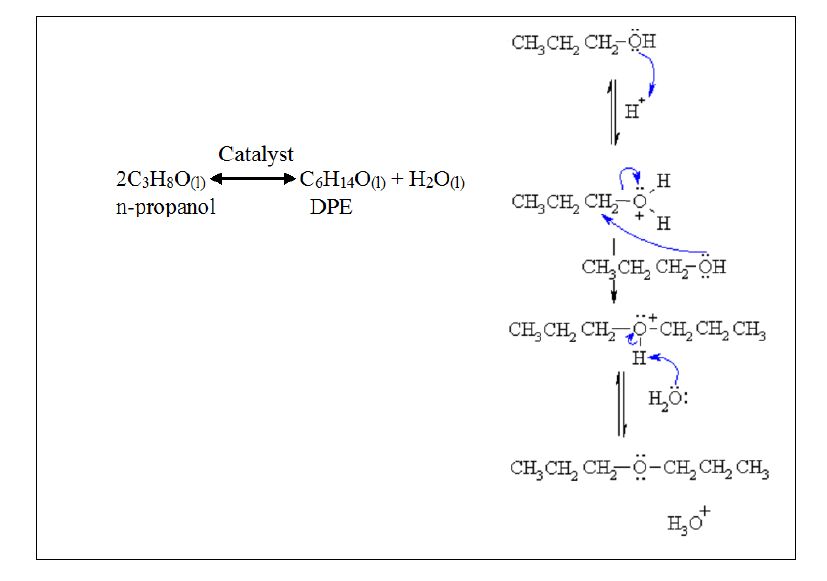
 DownLoad:
DownLoad: 